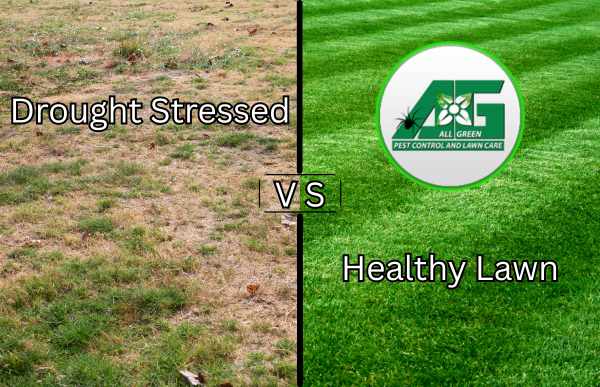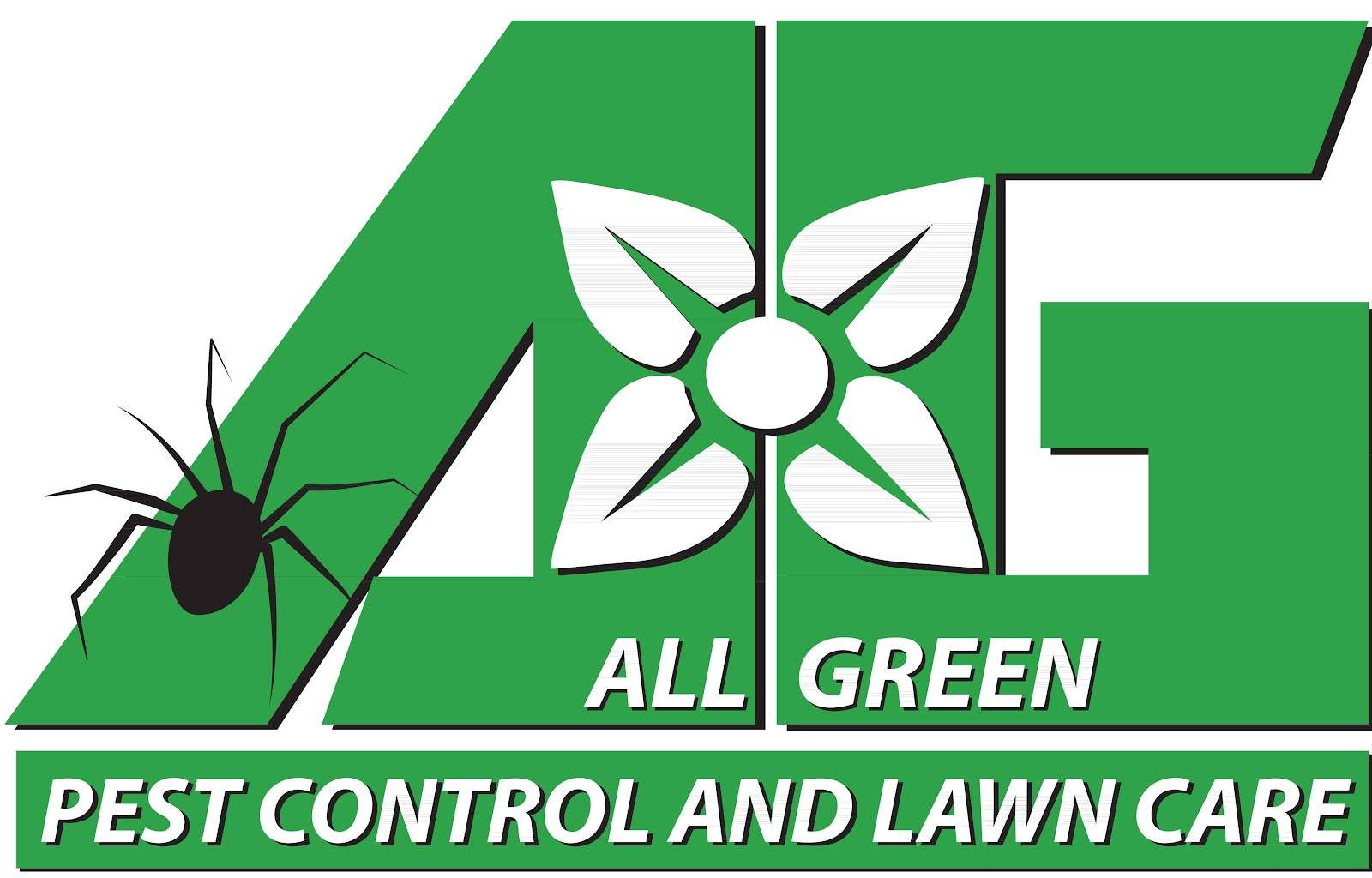
As summer temperatures soar across Utah—from St. George to Ogden—your lawn is under more pressure than any other time of year. From June through August, high heat and low humidity create extreme drought stress, and the number one reason lawns struggle is improper watering. At All Green Pest Control & Lawn Care, we see it every season: inconsistent sprinkler system performance causes under watering, over watering, and uneven sprinkler coverage that leads to dying grass.
In this post, we’ll walk you through how to detect watering-related issues, what they look like, and how to adjust your lawn care strategy based on your yard’s unique characteristics like soil type, slope, and shade.
Drought Stress in Lawns: What It Looks Like and How to Prevent It
Drought stress occurs when lawns lose water faster than they can absorb it, which is common during Utah’s peak summer heat. If your lawn isn’t equipped to handle extreme temperatures with consistent hydration, the grass will begin to suffer—sometimes beyond recovery.
Signs of Drought Stress:
- Grass blades turn bluish-gray, curl, or don’t bounce back after walking on them
- Brown, dry patches develop across the lawn
- Soil appears cracked, hard, or powdery even after watering
The Role of Hydrophobic Soil
A major contributor to drought stress is hydrophobic soil—a condition where the soil repels water instead of absorbing it. This commonly occurs in extremely dry or compacted soil, which forms a crust on the surface, causing water to run off instead of sinking in.
How to Fix It:
- Water daily in short bursts (5–10 minutes, 2–3 times in the early morning) for several days to rehydrate the soil gradually
- Once absorption improves, switch to deep, infrequent watering
- Use wetting agents or soil surfactants to help break through hydrophobic layers
(Source: Oregon State Extension)
Pro Tips:
- Adjust watering based on soil type: Sandy soils drain faster, clay soils retain water longer
- Test for proper hydration with a screwdriver: If it doesn’t go in easily, the soil is too dry
- Always water early in the morning to reduce evaporation and maximize absorption
(Source: University of California Agriculture)
Under Watering: The Most Common Cause of Dying Grass
When grass doesn’t get enough water, its growth slows, color fades, and roots shrink. It’s especially common on sloped areas, sun-drenched zones, or spots where sprinklers are misaligned.
Signs of Under Watering:
- Dull or grayish grass color
- Grass remains flattened after walking on it
- Soil is dry just below the surface
Causes:
- Not adjusting sprinklers for areas with high sun exposure
- Using the same schedule across shaded and full-sun zones
- Poor distribution due to blocked sprinkler heads
Solutions:
- Conduct a sprinkler system audit to measure and balance output across your yard
(Source: EPA WaterSense) - Increase watering time for dry areas, especially those with slopes or sandy soil
- Install drip irrigation or micro-sprayers for more precise application in difficult zones
Over Watering and Lawn Damage: Signs and Prevention
More water isn’t always better. Over watering can suffocate grassroots, promote fungal diseases, and lead to shallow root systems, leaving your lawn vulnerable in extreme heat.
Signs of Over Watering:
- Constantly soggy or spongy turf
- Yellowing grass, mushrooms, or fungal patches
- Thatch buildup and poor root development
Common Causes:
- Watering too frequently, often daily
- Ignoring weather conditions or irrigation during rainy periods
- Not adjusting for clay-heavy soil which drains slowly
Best Practices:
- Water 2–3 times per week, depending on weather and soil retention
- Use smart irrigation controllers to avoid watering during rain
(Source: Utah Division of Water Resources) - Watch for pooling or runoff, which may require shorter, staggered watering cycles
Diagnosing Sprinkler Coverage Issues: Avoiding Dying Grass and Dry Spots
Uneven sprinkler coverage can lead to both under and over watered zones. Dry patches, brown rings, and inconsistent growth are telltale signs that your system isn’t distributing water evenly.
How to Check for Coverage Issues:
- Place catch cups or tuna cans around the yard to measure water output
- Walk the lawn during irrigation and check for:
- Clogged or misaligned nozzles
- Misdirected heads
- Broken sprinkler components
Consider:
- Tree canopies and fences can block water spray
- Wind drift may cause uneven coverage
- Slopes require adjusted timing to avoid runoff and pooling at the bottom
Know Your Lawn: Adapting to Your Yard’s Unique Characteristics
Utah landscapes are diverse—no two yards require the exact same watering strategy. It’s essential to know your lawn’s soil composition, slope, shade coverage, and sun exposure in order to fine-tune your sprinkler system.
Key Lawn Zones to Consider:
- South-facing slopes need longer watering cycles
- Shaded areas under trees require less frequent watering
- Clay soils need slower, deeper watering to avoid surface runoff
- Sandy soils require shorter, more frequent cycles
Regular observation and small weekly adjustments can make a huge difference in maintaining a healthy, drought-resistant lawn.
Fertilization: Building a Drought-Resistant Lawn from the Roots Up
Beyond watering, fertilization plays a critical role in your lawn’s ability to survive summer heat. Fertilizers provide essential nutrients that strengthen grass cell walls, boost root development, and improve water retention.
Benefits of Fertilization:
- Encourages deep root systems that can access moisture deep in the soil
- Enhances the grass’s ability to recover from drought
- Reduces stress during temperature extremes
Apply a slow-release fertilizer every 6–8 weeks through the growing season to support strong, healthy turf
(Source: Utah State University Extension)
Serving Lawns Across Washington, Utah, Salt Lake, Davis & Weber Counties
At All Green Pest Control & Lawn Care, we’re Utah’s trusted experts in sprinkler system maintenance, lawn fertilization, and seasonal lawn care. We proudly serve homes and businesses in:
- Washington County – St. George and surrounding areas
- Utah County – American Fork, Provo, Lehi, Orem
- Salt Lake County – Draper, Midvale, Sandy, Murray
- Davis County – Layton, Kaysville, Farmington
- Weber County – Ogden, Roy, North Ogden
Contact All Green Today
Need help diagnosing watering issues or improving sprinkler performance? Contact one of our local offices:
St. George Office
1216 W Sunset Blvd, Suite A1
St. George, UT 84770
📞 (435) 256-6009
Utah County Office
2452 W Center St
Provo, UT 84003
📞 (801) 477-1289
Salt Lake County Office
207 W 4860 S
Murray, UT 84107
📞 (801) 566-1888
Visit our Contact Page to schedule service, get a quote, or chat with a lawn care specialist near you.
Identifying drought stress early is a helpful way to preserve the long term health of your lawn. In addition, you can learn about what the best type of turfgrass is for you based on your region and soil type.
